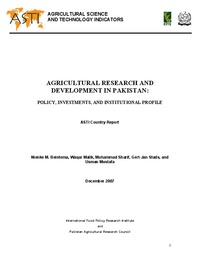Authors:
Beintema, Nienke; Malik, Waqar; Sharif, Muhammad; Stads, Gert-Jan; Mustafa, Usman
Year:
2007
Publisher
International Food Policy Research Institute (IFPRI); and Pakistan Agricultural Research Council (PARC)
Back to:
With nearly 3,600 fte researchers in 2003, Pakistan has one of the largest agricultural R&D systems in Asia. However, agricultural researcher totals in Pakistan have increased only slowly during the past two decades, mainly as a result of prolonged periods of recruitment restrictions. In addition, at just 15 percent in 2003, the share of Pakistani agricultural research staff trained to PhD level is relatively low, compared to some of Pakistan’s South Asian neighbors. Further, researchers at the government agencies face limited promotion opportunities, low salary levels, and few other incentives. Promotions, when they take place, are based on seniority and not on merit. This has led to a brain drain of researchers from the government sector to universities, non-research agencies, or to opportunities outside Pakistan.
Agricultural R&D expenditure in Pakistan contracted significantly during 1991–99 due to cuts in the government budget and the completion of large donor-funded projects, but rebounded somewhat since the establishment of ALP, a joint program between PARC and the United States Department of Agriculture. In 2003, the country invested $187 million in agricultural R&D (in 2000 international dollars), significantly lower than the $219 million recorded in 1991.
The organizational structure of agricultural R&D in Pakistan is somewhat complex, but with a clear distinction between federal- and provincial-level research agencies. Research conducted by federal government agencies is largely long-term priority research, while the research conducted at the provincial level is mostly adaptive at the provincial level. PARC is the country’s principal federal agency involved in agricultural R&D and it oversees a number of institutions that conduct agricultural research in a wide variety of agro-ecological zones within the country. One of these agencies is NARC, the country’s largest in terms of research staff and spending. In addition, each of Pakistan’s four provinces has a well established research institute attached to the Department of Agriculture. Each such provincial research institute has several satellite research stations, research farms and other research facilities in various commodities specific and agroecological zones within a province. At 10 percent of total research staff and spending, the higher education sector plays a relatively limited role in the conduct of agricultural R&D in Pakistan.
Agricultural R&D in Pakistan is still dominated by the public sector. By our estimates, private-sector agencies accounted for just 6 percent of the country’s agricultural R&D expenditures in 2003. Public agricultural R&D in Pakistan is heavily reliant on government sources of support. Foreign donor support has traditionally played an important role in financing agricultural R&D in Pakistan, although exact shares of donor funding were not available. The United States (through USAID and USDA) and
the World Bank (through ARP I and II), for example, have directed significant funds toward the establishment of new institutes, the upgrading of research equipment, as well as human resource development and degree-level training.

